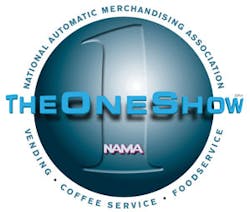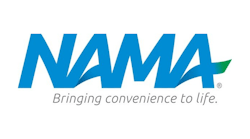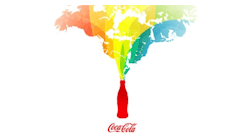As the nation’s businesses recover from a long and grueling recession, many have learned some important lessons.
One being that the future belongs to the leaders. To survive and to succeed, “standard” performance no longer cuts it. Top performance has become mandatory.
This truism applies to many industries. For automatic merchandising, it’s been obvious for several years.
For automatic merchandising, the need for change was evident long before the recession. A shrinking workforce, economic uncertainty and the changing consumption patterns of consumers have all contributed to the need for change.
The National Automatic Merchandising Association (NAMA) OneShow April 28 to 30 at Chicago’s McCormick Place West Hall is an event designed for leaders in automatic merchandising. The 3-day event signifies the most diverse, value-packed industry event ever conceived. One that has been several years in planning.
View the Show Schedule in PDF format
In 2005, the staff of Automatic Merchandiser met with NAMA’s professional staff to discuss how the two entities could work together to give guidance to a changing industry. Both organizations recognized the industry was changing in a way that would not allow a place for second rate performers.
The two organizations agreed to work together to pursue their common goal.
In November of 2005, Automatic Merchandiser published its “White Paper for Vending,” listing seven action steps that vending operators need to succeed. These steps formed the basis of the “Wake Up Vending” series of 2006.
One action step listed was “Be an industry leader,” which includes being involved in trade association activity, committing to new technology on some level, and having an action plan.
This year’s NAMA OneShow represents the fulfillment of that opportunity. The OneShow offers vending operators the chance to find technology resources. It will also avail opportunities to learn how to be the best in every aspect of automatic merchandising.
NAMA DEVELOPS AN ACTION PLAN
The NAMA staff shared the same basic vision as Automatic Merchandiser. Its board of directors turned this vision into action and put a plan in place to address these and other factors threatening vending, coffee service and foodservice.
As part of that plan, a comprehensive program approved in 2008 was actively initiated to combine NAMA’s Spring Expo and National Expo into The Oneshow.
A single spring event means companies can better focus marketing efforts and launch new products more effectively. In addition:
Exhibitors and attendees will enjoy significant cost savings.
All of the industry’s decision makers will be under one roof at one time.
One event is friendly to the environment with the elimination of an entire event carbon footprint.
In 2009, the NAMA board also began implementation of a new strategic plan intended to reinvent the industry and change perceptions among operators, customers, consumers, lawmakers and media — in short, everyone who “touches” the vending experience.
“We had to change the way everyone in this industry thinks and behaves,” said NAMA Chairman Craig Hesch, chief financial officer of A.H. Management Services in Rolling Meadows, Ill. “Now, if each of us doesn’t step up and accept the challenges we face as an industry, there could be dire consequences. If nothing changes, then nothing changes!”
AN INDUSTRY IN THE MIDST OF CHANGE
A constant buzz related to new technologies can be heard throughout the industry. Specific examples include new Vending Data Interchange standards launched by NAMA in September 2009; the diji-touch machine from Crane, Kraft and Samsung; and Coca-Cola’s interactive video vending machine, among others. The new machines are in field testing now and will move toward commercialization soon, promising a lasting change in the consumer vending experience.
Meanwhile, NAMA is hard at work negotiating with credit/debit card processing companies to make cashless payment options viable and affordable in the vending channel.
The OneShow is the only place and time in 2010 for operators to learn as much as possible about the changes in the industry, to meet the key players behind it, and to see what’s new.
A REDESIGNED SHOW FLOOR
The show has also been redesigned to help attendees discover new ideas for increasing their own sales and profits, find answers to pressing questions, and learn about new research findings that can help build business. Thve education sessions — completely free to registered attendees — will offer practical, hands-on knowledge.
A redesigned show floor will feature wide aisles and specialty pavilions: coffee service and water; new exhibitors; and foodservice and catering. The new layout features 20-foot-wide “Main Streets” that stretch all the way from the front of the hall to the back, giving attendees front-row exposure to the exhibitors.
The new show floor also features a center stage, which will serve as the focal point for OneShow entertainment, including painters, sculptors, jugglers, mimes, musicians and celebrities.
A 20-foot flat-screen monitor will project what’s happening throughout the show.
TECHNOLOGY TAKES CENTER STAGE
Many industry observers have noted the importance of technology to the industry’s future. The OneShow will include several education seminars focusing on technology developments, such as the new Vending Data Interchange standards.
In addition, the floor will be filled with “iSpots,” a brand new emblem that’s designed to indicate what’s new, innovative and notable among exhibitors. All iSpot entries will be evaluated by an independent judging panel to receive a NAMA Innovation Award, also new this year and intended to recognize the innovations that are changing the industry every year.
The lineup of keynote speakers is like never before, from ABC-TV’s Ted Koppel to Godfather Pizza’s Herman Cain to the NFL’s Terry Bradshaw. Plus, legendary coach and restaurateur Mike Ditka will emcee the industry awards ceremony this year, slated for Thursday, April 29, followed by a reception.









